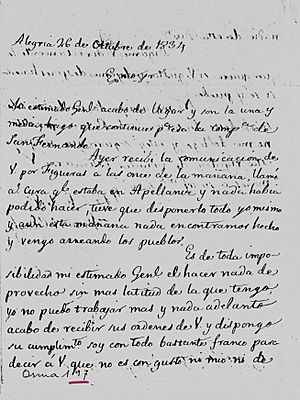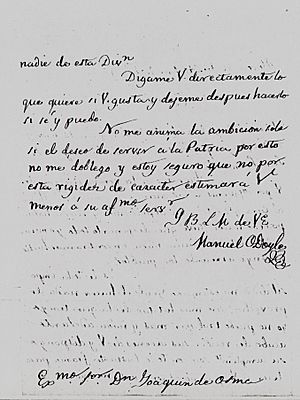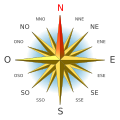Battle of Alegría de Álava facts for kids
Quick facts for kids Battle of Alegría de Álava |
|||||||
|---|---|---|---|---|---|---|---|
| Part of First Carlist War | |||||||
|
The town of Alegría-Dulantzi |
|||||||
|
|||||||
| Belligerents | |||||||
|
Carlists supporting |
Liberals (Isabelinos or Cristinos) supporting Isabella II of Spain and her regent mother Maria Christina |
||||||
| Commanders and leaders | |||||||
| Tomás de Zumalacárregui Manuel Iturralde |
Manuel O'Doyle | ||||||
| Casualties and losses | |||||||
| ~600 | |||||||
The Battle of Alegría de Álava was an important fight during the First Carlist War in Spain. It happened on October 27, 1834, near the town of Alegría de Álava. The Carlists won this battle.
Carlist forces were led by Tomás de Zumalacárregui. He surprised the Liberal (also called Isabeline) troops, who were led by Manuel O'Doyle.
What Led to the Battle?
The First Carlist War was a civil war in Spain. It was fought between two main groups:
- The Carlists: They supported Infante Carlos, Count of Molina, who believed he should be king.
- The Liberals: They supported Isabella II of Spain, who was a young queen, and her mother, Maria Christina, who ruled for her.
Liberal Army Struggles in 1834
In the summer of 1834, the Liberal army, led by General José Ramón Rodil, tried to defeat the Carlist army and capture Infante Carlos. But Rodil's army lost many soldiers to the Carlists. By September 1834, Rodil had to give up his command to Manuel Lorenzo.
Rodil then marched towards Madrid. As he got close to Vitoria-Gasteiz, a group of soldiers led by O'Doyle joined him as guards. These soldiers were part of the Liberal Army of Navarre. Rodil, without permission, placed O'Doyle's troops under the command of Joaquín de Osma. Osma was the general in charge of the Basque Provinces and was based in Vitoria.
Carlist Movements and Plans
The Liberal troops from Navarre were now smaller and couldn't keep up with the fast movements of Zumalacárregui's Carlist army. Zumalacárregui moved towards the Ebro River. He planned to attack Ezcaray, a town about 40 kilometers (25 miles) south of the river. Ezcaray had important factories that made cotton cloth. Zumalacárregui wanted this cloth to make winter uniforms for his soldiers.
On October 20, 1834, Zumalacárregui learned that a convoy (a group of vehicles carrying supplies) of weapons was traveling from Burgos to Logroño. This convoy would use a main road near the Ebro River.
Zumalacárregui's Pursuit of the Convoy
On October 21, Zumalacárregui decided to chase the convoy. He took four battalions (large groups of soldiers) and three squadrons (groups of cavalry). He crossed the Ebro River at Tronconegro. However, the convoy had already passed.
Zumalacárregui quickly marched after the convoy. But he was stopped at Cenicero by local townspeople who supported the Liberals. They were stationed in the church. Zumalacárregui had to go around the town. His cavalry managed to catch up with the convoy, which was almost at Logroño. Zumalacárregui captured these valuable supplies. He then burned down the church in Cenicero. On October 22, he crossed the Ebro River again and marched towards Navarre. His troops then stayed in towns in the Berrueza valley.
Liberal Response to Carlist Movements
On October 21, the Liberals in Vitoria finally heard about Zumalacárregui's movements. Osma ordered O'Doyle to march his soldiers to the Ebro River at Peñacerrada. The goal was to block Zumalacárregui. O'Doyle's group included several regiments, like the Queen's First and Second Regiments.
O'Doyle reached Peñacerrada on the afternoon of October 22. He learned that the Carlists were north of the Ebro. The next day, O'Doyle marched through the valley of the Ega River. His troops rested that night at Lagrán. On October 24, the Liberal soldiers reached Maeztu.
The Liberal troops were very tired and didn't have enough supplies. So, they rested for a whole day on October 25. On October 26, they left Maeztu, crossed the mountains of Andia, and after marching for 22 kilometers (14 miles), they arrived at Alegría de Álava.
O'Doyle's Disagreement with Orders
Osma then ordered O'Doyle to spread out his soldiers. Only a few troops were to stay at Alegría de Álava. The rest were to be stationed in nearby villages like Guevara, Arroyabe, and Ullíbarri-Gamboa (Uribarri-Ganboa). These places were 6, 12, and 13 kilometers (4, 7, and 8 miles) north of Alegría de Álava.
O'Doyle did not agree with this order. He talked to his captains, who also thought it was a bad idea. But they followed the order anyway, leaving Alegría de Álava and moving to the other villages. O'Doyle wrote a letter to Osma, explaining his worries about the order.
Meanwhile, Zumalacárregui was 48 kilometers (30 miles) south of Alegría de Álava. His customs officers (called aduaneros) were watching the movements of the Liberal troops. They told Zumalacárregui when O'Doyle's troops left Alegría de Álava. Zumalacárregui received this news in the afternoon.
Zumalacárregui didn't have enough soldiers to fight a whole Liberal division. But he had enough to fight a few battalions. So, he decided to go to Álava and attack the Liberal troops who were heading to the different villages. That night, Zumalacárregui left a few men behind to keep campfires burning. He took his main army to Campezo, Zúñiga, and Orbiso, where they spent the night. Now, Zumalacárregui was only 35 kilometers (22 miles) from Alegría de Álava. General Lorenzo, the Liberal general, saw the campfires at Berrueza and thought Zumalacárregui's troops were still there.
The Battle Begins
On October 27, Osma arrived early at Alegría de Álava. He explained to O'Doyle why he had ordered the Liberal troops to spread out. Osma had heard that Carlos, who wanted to be king, was in Oñate. O'Doyle's soldiers, now in four groups, were supposed to leave Alegría de Álava that afternoon. They would march through the night to reach Oñate by different routes and capture Carlos.
Meanwhile, the Carlist army was ready. Zumalacárregui gave his soldiers a drink called aguardiente, which was his custom before a battle. The army was split into two groups. One group was led by Manuel Iturralde. It had several battalions and was ordered to climb the mountains from Saseta. The other group was led by Zumalacárregui himself. It included special units like the Guías de Navarra and the lancers. This group would advance from Ullíbarri-Gamboa (Uribarri-Ganboa).
Carlist Strategy and Surprise Attack
As they marched, the Carlists captured anyone they saw, like people working in the fields. They kept them guarded so no one could warn the Liberals. Soon, the Carlists noticed there was no one around, which made them realize the Liberal army was close.
Zumalacárregui learned that General Lorenzo still didn't know about the Carlist advance. Lorenzo was still at Los Arcos. Zumalacárregui decided to send a small number of soldiers to attack Salvatierra (Agurain), which was 10 kilometers (6 miles) east of Alegría de Álava. Zumalacárregui would hide with his main troops in the forest of Chinchetru (Txintxetru). They would wait for O'Doyle, who they expected to leave his headquarters to defend Salvatierra.
At the same time, Iturralde would come down from Saseta and hide in the wooded mountains south of Alegría de Álava. Once O'Doyle left for Salvatierra, Iturralde would march alongside him. When Zumalacárregui started his attack at Chinchetru, Iturralde would attack the Liberals from their right side.
Things worked out well for Zumalacárregui. As he marched towards Chinchetru, he met the governor of Salvatierra, who was heading to Vitoria with some prisoners. At 4:00 PM, O'Doyle's troops began to leave Alegría de Álava, heading north. Suddenly, gunshots were heard at Chinchetru. Zumalacárregui made his soldiers fire into the air to make the gunfire sound louder. Then, he hid in the forest north of Alegría de Álava.
O'Doyle stopped heading north and instead went east, through the hills. This was a shorter way to Chinchetru. The ground was rough, with many trees, and not easy for soldiers to march through. Also, the setting sun made the Liberal soldiers' weapons shine brightly. This made it easy for Zumalacárregui to spot them from Chinchetru.
Fierce Combat and Liberal Retreat
Zumalacárregui ordered the Guías de Navarra to leave the forest and move to the open field between Chinchetru and the hills. The first group of Liberal soldiers, led by O'Doyle on horseback, were mountain troops (called cazadores). They marched much faster than the rest of the Liberal army.
These Liberal troops soon saw the Guías de Navarra, who wore their famous red berets. They were surprised to see the Carlists there. O'Doyle ordered an attack, but the Liberal cazadores were quickly pushed back by the Guías de Navarra.
When the rest of the Liberal troops arrived, Zumalacárregui ordered all his soldiers into battle. A fierce fight began.
One historical account describes the Carlist attack:
Zumalacarregui, though inferior in numbers, and without a single piece of cannon, yet perceiving from the impatient countenances of his men that they were eager to attack, at once gave his customary word of command, A ellos, muchachos! (At'em, my boys!) and with enthusiastic shouts of Aurrera mutillac! ["At’em, my boys" in Basque] the whole line moved on like a torrent.
Meanwhile, the Carlist general Iturralde also appeared. He attacked the Liberal soldiers from behind and on their right side. The Liberal troops became confused. They couldn't organize themselves in such a small space. After firing one round of shots, they couldn't defend themselves from a strong Carlist bayonet attack (a bayonet is a knife fixed to the end of a rifle). The Liberal soldiers began to surrender.
The sounds of the battle reached the nearby villages of Guevara, Arroyabe, and Ullíbarri-Gamboa, where the other Liberal troops were stationed. These Liberal soldiers started marching towards Chinchetru. But soon, they met Liberal troops who had run away from the battle, which was becoming a disaster. These fleeing soldiers told them what was happening. So, the retreating Liberal soldiers and the troops from the three villages all fled to Vitoria, reaching it by night.
After the Battle
During the night, the Carlists searched the forests between Chinchetru and Alegría de Álava for any Liberal soldiers who had survived and were hiding. Any Liberals they found were captured or killed.
The Carlists captured two cannons that belonged to the Liberal army. They also took ammunition, supplies, and the flag of the Liberal Regiment of Africa. O'Doyle, his brother, and other officers surrendered. They were executed the next day by a firing squad. About 400 Liberal soldiers were taken prisoner.
However, about 250 Liberal soldiers and their officers managed to stay organized. They marched quickly to Arrieta, which was 3 kilometers (2 miles) from the battlefield. They fortified themselves in the church there. They fought against the Carlists who chased them all night.
News of this fight at Arrieta led Osma to send soldiers to rescue the troops there. This led to another battle, the Battle of Venta de Echávarri, which happened on October 28, 1834.
Images for kids
See also
 In Spanish: Acción de Alegría de Álava para niños
In Spanish: Acción de Alegría de Álava para niños






